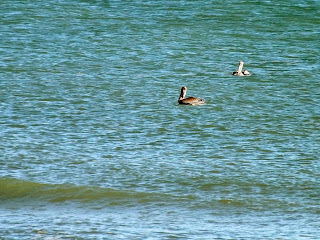I spent the afternoon yesterday sitting on the overview ramp that leads to the beach. The sun was warm and it was a great sight when the pelicans and osprey were diving into the ocean for fish. These are their ways: pelicans dive beak first for their catch - osprey dive head first then switch at the last second to grab prey with their feet. Since I had my camera handy, I thought I would try to get their action. What a failure I had with those shots. I'm used to taking pictures of still and close up things and this was VERY different. I pushed to focus then pushed to take a photo and my subject matter was just plain too fast for me. I even had camera set to "sport" which could have stopped action if I could have them in the right place when I shot. Part of my problem was that they were so far away and I'm not a professional photographer with an adequate zoom lens nor knowledge of what tactic and settings to use. The photos below are my poor results but I WILL try again. I took 38 shots so was satisfied to have a few to share. Unfortunately I missed the osprey completely.


























After two hours I headed for home and noticed shapely brown clumps on a neighbor's lawn. Curiosity prevailed and these are my best photo accomplishments of the day. Of course, after returning home I had to research and be able to name them. I'm still not sure of identification, as it is tricky, and I NEVER would eat these even though I love tasty fungi.
Boletus queletii otherwise known as the deceiving bolete, is an uncommon, edible mushroom in the genus Boletus. It can be found in deciduous forest, at lower altitudes, mostly under beech.
Boletus is a genus of mushroom, comprising over 100 species. The genus Boletus was originally broadly defined and described by Elias Magnus Fries in 1821, essentially containing all fungi with pores.
Boletus queletii
Boletus queletii
Boletus queletii
Boletus queletii
Boletus queletii
Boletus queletii












